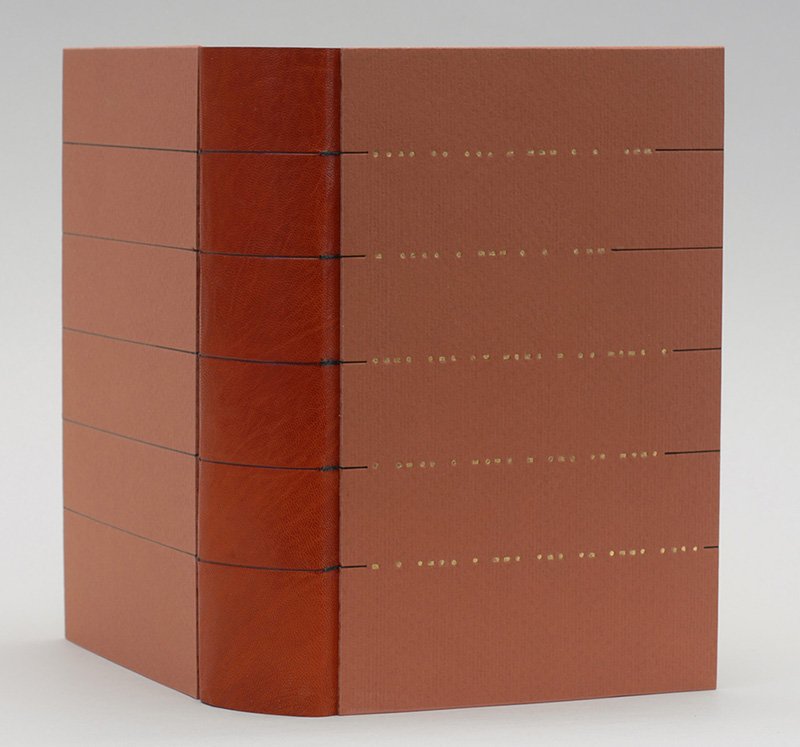 Image 1 of 4
Image 1 of 4

 Image 2 of 4
Image 2 of 4

 Image 3 of 4
Image 3 of 4

 Image 4 of 4
Image 4 of 4





Of the Decorative Illustration of Books
Of the Decorative Illustration of Books Old and New by Walter Crane, London and New York: George Bell and Sons, 1896, printed at Chiswick Press (first edition).
Collection of the University of Chicago
Bound for Artistically Reversible: Where Conservation and Art Meet, an online exhibition ‘to create compelling new work that applies non-destructive and completely reversible book structures’ based on the work of the Tomorrow’s Past movement. Bound 2011.
Modified Simplified binding.
Of original cloth case, only the heavily water-damaged rear board and a fragment of front board bearing the title remained. Staining only visible on the gilt head and the final few signatures, which contain plates on coated paper. Thread weak and sewing broken in places.
Book disbound and resewn on ramieband. Discolored tissues adjacent to plates discarded. Single page with detached corner repaired. Interior and exterior folios of each signature guarded to protect folds when resewing. Pasted up (no PVA) and rounded but not backed, “superior archival millboard” boards beveled at inside spine edge to match natural round. Spine linings of Japanese tissue, linen, then alum-tawed calf sanded smooth to even spine.
New endpapers, double folio of “W S H & Co” watermarked handmade paper from Wookey Hole Mill, could possibly approach the age of the book. Boards covered in decorative paper acquired at a Guild of Book Workers auction marked “Italian old.” Handsewn three color silk headbands, spine piece covered in Harmatan goatskin. New label is frontispiece from text, scanned and inkjet-printed onto vellum. Minimal gold tooling on spine echoes pattern of decorative paper.
19 x 15.5 x 4.5 mm, 7.5 x 6.25 x 2”
As a non conservator, my challenge with Artistically Reversible was to let the needs of the book and a philosophy of minimal intervention dictate the treatment, rather than my usual practice of making the book subordinate to my conceptual desires. Several candidates were dismissed because their condition did not merit resewing or the discard of their detached, but sound, boards. I have a new appreciation for those distressed but still handsome 18th century books, now as examples of period design and structure, rather than as raw materials for an art project.
Of the Decorative Illustration of Books Old and New by Walter Crane, London and New York: George Bell and Sons, 1896, printed at Chiswick Press (first edition).
Collection of the University of Chicago
Bound for Artistically Reversible: Where Conservation and Art Meet, an online exhibition ‘to create compelling new work that applies non-destructive and completely reversible book structures’ based on the work of the Tomorrow’s Past movement. Bound 2011.
Modified Simplified binding.
Of original cloth case, only the heavily water-damaged rear board and a fragment of front board bearing the title remained. Staining only visible on the gilt head and the final few signatures, which contain plates on coated paper. Thread weak and sewing broken in places.
Book disbound and resewn on ramieband. Discolored tissues adjacent to plates discarded. Single page with detached corner repaired. Interior and exterior folios of each signature guarded to protect folds when resewing. Pasted up (no PVA) and rounded but not backed, “superior archival millboard” boards beveled at inside spine edge to match natural round. Spine linings of Japanese tissue, linen, then alum-tawed calf sanded smooth to even spine.
New endpapers, double folio of “W S H & Co” watermarked handmade paper from Wookey Hole Mill, could possibly approach the age of the book. Boards covered in decorative paper acquired at a Guild of Book Workers auction marked “Italian old.” Handsewn three color silk headbands, spine piece covered in Harmatan goatskin. New label is frontispiece from text, scanned and inkjet-printed onto vellum. Minimal gold tooling on spine echoes pattern of decorative paper.
19 x 15.5 x 4.5 mm, 7.5 x 6.25 x 2”
As a non conservator, my challenge with Artistically Reversible was to let the needs of the book and a philosophy of minimal intervention dictate the treatment, rather than my usual practice of making the book subordinate to my conceptual desires. Several candidates were dismissed because their condition did not merit resewing or the discard of their detached, but sound, boards. I have a new appreciation for those distressed but still handsome 18th century books, now as examples of period design and structure, rather than as raw materials for an art project.























